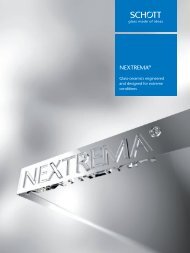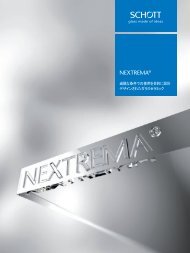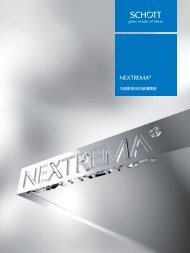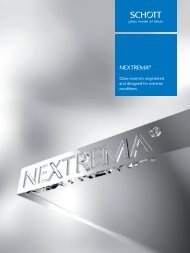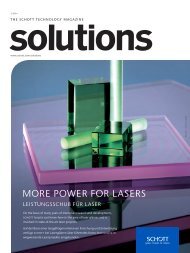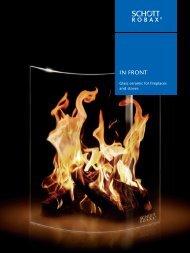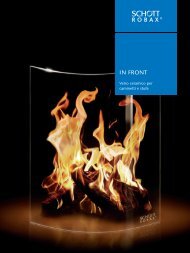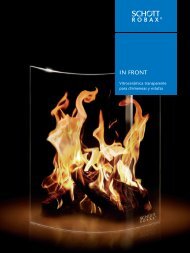SCHOTT Technical Glasses
Apart from its application in optics, glass as a technical material has exerted a formative influence on the development of important technological fields such as chemistry, pharmaceutics, automotive, optics, optoelectronics and information technology. SCHOTT Technical Glasses offers pertinent information in concise form. It contains general information for the determination and evaluation of important glass properties and also informs about specific chemical and physical characteristics and possible applications of the commercial technical glasses produced by SCHOTT. With this brochure, we hope to assist scientists, engineers, and designers in making the appropriate choice and make optimum use of SCHOTT products.
Apart from its application in optics, glass as a technical material has exerted a formative influence on the development of important technological fields such as chemistry, pharmaceutics, automotive, optics, optoelectronics and information technology. SCHOTT Technical Glasses offers pertinent information in concise form. It contains general information for the determination and evaluation of important glass properties and also informs about specific chemical and physical characteristics and possible applications of the commercial technical glasses produced by SCHOTT. With this brochure, we hope to assist scientists, engineers, and designers in making the appropriate choice and make optimum use of SCHOTT products.
Create successful ePaper yourself
Turn your PDF publications into a flip-book with our unique Google optimized e-Paper software.
61<br />
and unique solution, particularly in high temperature environments.<br />
The material is manufactured e.g. in sheet form and can be<br />
further processed by using a wide variety of technologies.<br />
The following different features are in principal producible –<br />
all others upon request:<br />
• Cut to size panels, flat, and surface smooth<br />
• Ground in random shapes and with inner cuttings<br />
• Ground, polished, with bevelled edges or drilled holes<br />
Nextrema is a type of glass-ceramic consisting of a crystalline<br />
and a residual glassy phase. The glass is obtained e.g.<br />
by a rolling process and is subsequently subjected to a heat<br />
treatment as described in the introduction before. This is<br />
called ceramization which transforms, in a controlled manner,<br />
the glass almost completely into both a fine grained<br />
crystalline phase and a residual glassy phase. Mainly different<br />
ceramization processes determine both the features and<br />
the types of Nextrema available. Therefore no one type<br />
of NEXTREMA is like another. The approach is to design<br />
glass-ceramic that corresponds to the individual and specific<br />
requirements as precisely as possible. Each product feature<br />
individually or particularly combined can lead to new technical<br />
developments and fields of application.<br />
The ceramic types are available in 4 types, generally:<br />
I. transparent<br />
II. tinted<br />
III. translucent (white colored)<br />
IV. opaque (white or grey colored)<br />
4. Smooth, non-porous surface and process inertness<br />
NEXTREMA is process inert. Even under extreme conditions,<br />
the material will not have negative interactions<br />
with the process environment. There are no interfering<br />
process factors such as gas emissions from organic components.<br />
5. Wide transmittance spectrum means high transmittance<br />
for wavelengths covering the visible and infrared range.<br />
6. Very low transmittance for ultraviolet range.<br />
7. High dimensional and shape stability of objects made<br />
from these ceramic materials.<br />
These outstanding technical properties guarantee suitability<br />
for a wide range of technical applications, e.g.<br />
• Solar processing<br />
• LCD/OLED processing<br />
• Heating/Lighting (e.g sauna, space heating, IR-heating/<br />
drying)<br />
• Food processing (e.g. grills, toasters, outdoor fireplaces,<br />
microwave applications)<br />
• Setters for firing electronic components<br />
• Carrier plates in CVD-furnaces<br />
• Cover panels for heating elements and burners<br />
• Cover panels for projectors/beamers/photocopiers<br />
• Windows for combustion furnaces<br />
• Interior panels of oven doors<br />
• Carrier/protection plates for food processing industries<br />
• Linings for furnaces<br />
• Ceramic carrier plates for sputtering and solar production<br />
The technical basis of NEXTREMA covering a family of<br />
high-performance glass-ceramics is formed by main seven<br />
product features.<br />
1. Near zero thermal expansion and thereby with excellent<br />
thermal strength, Nextrema glass-ceramic consists of a<br />
material that has an intelligent microstructure specifically<br />
designed to achieve very low thermal expansion and<br />
excellent heat resistance.<br />
2. Robustness at high operating temperatures (up to<br />
950 C °/1742 °F) and high thermal shock resistance (up to<br />
800 C °/1472 °F).<br />
3. High chemical resistance like multiple resistance to acids<br />
and bases and impermeability with gas.<br />
Nextrema high-performance glass-ceramic<br />
10






